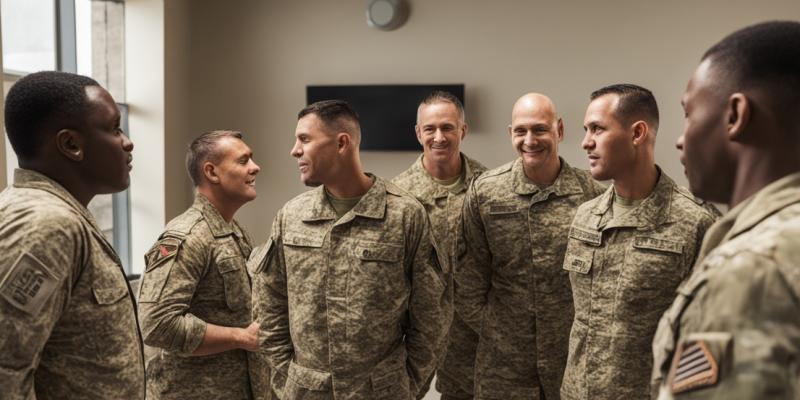Understanding Military Sexual Trauma (MST) in Men: Prevalence, Treatment, and Challenges
STORY / 20.06.24 / 3 min read
by Tom Garber

Understanding Military Sexual Trauma (MST) in Men: Prevalence, Treatment, and Challenges
Military Sexual Trauma (MST) is a significant and often overlooked issue affecting male service members and veterans. This article synthesizes findings from three comprehensive studies on MST to provide a detailed understanding of its prevalence, treatment principles, and the unique challenges faced by male survivors.
Prevalence of MST in Men
MST is defined as psychological trauma resulting from a physical assault of a sexual nature, battery of a sexual nature, or sexual harassment that occurs during military service. Research indicates that approximately 1%-3% of male service members and veterans experience MST, translating to thousands of affected individuals (Hoyt et al., 2012; Kimerling et al., 2007). Despite lower percentages compared to female counterparts (20%-43%), the absolute number of cases among men is substantial due to the higher number of men in the military.
Studies conducted by the Department of Defense (DoD) and the Veterans Affairs (VA) Health Care System reveal consistent MST rates among men. For instance, DoD studies from 2005 and 2008 reported MST prevalence rates of 1.4% to 2.7% among men, with an increase noted over time (Bray et al., 2009). Similarly, VA studies indicate that approximately 1.1% of veteran men have experienced MST, equating to over 30,000 identified cases (Kimerling et al., 2007).
Treatment Principles and Models for MST
Addressing MST-related PTSD in men involves several therapeutic approaches, often tailored to the unique experiences and symptoms of male survivors. Hoyt et al. (2012) propose a treatment model integrating various empirically supported therapies, such as Dialectical Behavior Therapy (DBT), Seeking Safety, and Cognitive Processing Therapy (CPT). This model follows Herman’s trauma recovery stages of safety, mourning, and reconnection, emphasizing trust-building, distress tolerance, and emotional regulation.
1. Safety Phase: Focuses on establishing trust and safety within the therapeutic environment. Techniques include psychoeducation on MST and PTSD, interpersonal effectiveness, and physiological regulation.
2. Mourning Phase: Involves trauma-focused treatments, such as CPT, where survivors process their traumatic experiences in a supportive group setting. This phase aims to challenge cognitive distortions related to self-blame and esteem.
3. Reconnection Phase: Centers on reintegrating survivors into daily life, fostering social bonds, and applying newly learned skills and beliefs to improve overall functioning and well-being.
Unique Challenges for Male Survivors
Male survivors of MST face distinct challenges that can impact their willingness to seek and benefit from treatment. Gender norms and societal myths, such as the notion that men cannot be overpowered or are only raped in prison, contribute to significant underreporting and stigma (Groth & Burgess, 1980). Studies indicate that men who have experienced MST report higher rates of psychopathology and lower treatment engagement compared to women (Elliott et al., 2004; Kimerling et al., 2008).
Moreover, male MST survivors often encounter multiple assailants during a single incident, a factor that can exacerbate trauma symptoms and complicate recovery (Foote & Goodman-Delahunty, 2005). Addressing these gender-specific experiences in therapy is crucial for effective treatment.
The Need for Comprehensive and Inclusive MST Programs
Despite the prevalence and severity of MST in men, treatment programs have historically received less financial support compared to those for women (Leskela et al., 2001). Universal screening for MST in the VA, implemented since 1999, has helped identify affected individuals, but there remains a lack of standardized treatment guidelines and gender-specific practices (Turner & Frayne, 2004; Kimerling et al., 2008).
Effective MST programs should integrate trauma-focused group therapy, psychoeducation, and wellness activities to support male survivors. Personal accounts from veterans highlight the importance of connecting with peers who share similar experiences, underscoring the therapeutic value of community and mutual support (Helle, 2004).
Conclusion
Military Sexual Trauma in men is a critical issue that demands increased attention, research, and resources. By understanding the prevalence, implementing comprehensive treatment models, and addressing the unique challenges faced by male survivors, we can better support their recovery and improve their quality of life.
References
- Hoyt, T., Rielage, J. K., & Williams, L. F. (2012). Military sexual trauma in men: Exploring treatment principles. *Traumatology, 18*(3), 29-40.
- Kimerling, R., Gima, K., Smith, M. W., Street, A., & Frayne, S. (2007). The Veterans Health Administration and Military Sexual Trauma. *American Journal of Public Health, 97*(12), 2160-2166.
- Bray, R. M., et al. (2009). 2005-2008 DoD Survey of Health Related Behaviors Among Active Duty Military Personnel. *Department of Defense*.
- Groth, A. N., & Burgess, A. W. (1980). Male rape: Offenders and victims. *American Journal of Psychiatry, 137*(7), 806-810.
- Elliott, D. M., Mok, D. S., & Briere, J. (2004). Adult sexual assault: Prevalence, symptomatology, and sex differences in the general population. *Journal of Traumatic Stress, 17*(3), 203-211.
- Leskela, J., Dieperink, M., & Kok, E. (2001). Group therapy for military sexual trauma: A case study. *Journal of Traumatic Stress, 14*(3), 237-245.
- Helle, H. (2004). Personal experiences of veterans in MST programs. *Veterans Affairs Health Care System*.